
Andy Lloyd's Dark Star Blog

Blog 32 (November 2015)
Earth's Primordial Waters
Regular readers of this blog will recognise the running theme of the Deuterium/Hydrogen isotope of water. A quick click through my previous blogs will pick up any number of articles on the subject, along with pertinent scientific references. Let me take a moment to re-cap.
Hydrogen in H20 takes two forms - the regular hydrogen, and the heavier isotope of hydrogen, deuterium. The amount of hydrogen and deuterium in any given sample of water varies across the solar system. In the colder, outer zones of the solar system, deuterium is found in proportionately greater abundance compared with the warmer, inner zone. So, water found on comets should have a higher deuterium levels than on the main-belt asteroids, for instance.
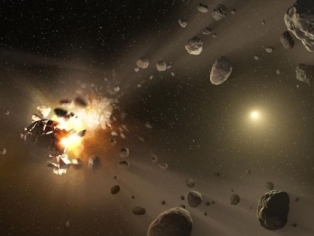
This is helpful when trying to establish where Earth's water came from. There's a fundamental problem with this, however, as the action of the Sun on the primordial Earth should have driven off most of the volatiles, like water, leaving the planet a dry husk fairly early on. Given that we self-evidently have an abundance of oceanic water on our planet creates a dilemma, solved for a long time by the 'late veneer theory' of water deposition on the Earth surface by impacting comets.
This is where the deuterium/hydrogen ratios come in. By that thinking, then, the Earth's water should resemble that of the outer solar system comets. As it turns out, it doesn't. Not only that, but the comets don't appear to be anywhere near as water-laden as once thought. Unexpectedly, perhaps, the Earth's water more closely resembles the outer asteroids from the main belt.
This matters when we consider aspects of Zecharia Sitchin's theory regarding the origin of the planet Earth. His rather unusual suggestion, based upon his reading and interpretation of ancient Mesopotamian texts, is that the Earth began its life where the asteroid belt currently resides. It was initially a larger, water-covered planet (equated in the myths with the aqueous monster Tiamat) which was bludgeoned by the usurper Marduk - a huge, fiery planet of unknown origin. Tiamat was rendered asunder - forming the asteroid belt, and delivering the core remnant of the old planet deeper into the inner solar system to become Earth.
So, if Sitchin's theory is to be believed, then one would expect that the Earth's water would be (a) in place from the beginning, (b) resemble water contained within the rest of the debris in the asteroid belt, and (c) have very little to do with long-period comets from the Oort Cloud (although some short period comets may, like the asteroids, turn out to be remnants of the ancient collision).
The advantage of this theory, scientifically, is that it solves all aspects of the Deuterium/Hydrogen ratio conundrum. Water was readily available on the primordial Earth's surface, unaffected by the heat of the Sun because of its greater initial distance. Some of the water was lost during the collision, providing isotopic clues in other regions of the inner solar system. Long period comets do not play a significant part in the story - the mass collisions of objects which bombarded the inner solar system about 3.9 billion years ago were not comets, but rather multiple collisions associated with the passages of the fiery planet Marduk, and its retinue. The chipped Earth migrated inwards, but at a time when its waters were safe from expulsion by the young Sun. It also explains why water is turning up in all kinds of unexpected nooks and crannies in the inner solar system - like deep within lunar craters, for instance.
It's a complicated picture, to be sure, and none of this is terribly easy to grasp without some due consideration. But, I suspect most readers of this blog are more than capable of due consideration, otherwise you'd have stopped reading quite a while ago, right?
Okay, so any new data on isotopic ratios is of interest to myself and my fellow researcher Lee Covino, who spearheaded the Sitchinite connection to this science as long ago as 2002 (1). He keeps an eye on the latest science, at a time when new data from probes to the comets and asteroids has thrown the late veneer theory into disarray. Astronomers are coming around to the realisation that water was abundant on the Earth very early on, seemingly unaffected by the action of the Sun (2). Of course, it's not just astronomers who are interested in solving this puzzle.
Geophysicists also have more than a casual interest in the Earth's water. Their own perspective is generally closer-to-home, and the theories they generate about the origins of the Earth's water tend to be more Earth-centric, and less cosmic. An example was the recent paper about zircon crystals I discussed in last month's blog (3), where geochemists argued that photosynthesis must have been taking place on Earth way earlier than might be considered possible from the perspective of the late veneer theory (4). There have also been concerns that the loss of hydrogen into space over billions of years has unhelpfully raised the relative deuterium level in the Earth's surface waters, rendering oceanic water a poor marker for investigations into the origin of terrestrial water in general (5).

Now, more arguments for early terrestrial water are emerging, presumably buoyed by this shift in the scientific consensus. A new paper, regarding the analysis of water found in ancient lava magmas from Iceland, suggests that the water has been here all along (6). The deuterium level in this pristine primordial water, untainted by later processes, is much lower than Earth's oceanic water (7). It suggests an origin within the inner solar system. The authors argue that the water came from water-laden dusts within the protoplanetary disk, which locally accreted into the Earth.
Of course, one might also argue, in this jumbled, complex field of scientific enquiry, that the higher deuterium ratio of the oceanic waters is an indication of mixing into the brew large amounts of comet water. Other internal factors weighing into this debate include a 'whole-Earth water cycle' potentially moving waters around between the oceans and internal terrestrial reservoirs deep, deep down in the bowels of the Earth (8).
Nonetheless, the fact that this pristine terrestrial water discovered within magma is so low in deuterium does at least allow us to conclude that the early Earth was chock-full of inner solar system water. In that, at least, we can be assured. A water world was, of course, Sitchin's description of Tiamat (9). This does not allow us to completely validate his arguments, of course, but they are at least consistent with the complexities of the emerging scientific data.
Written by Andy Lloyd, 24th November 2015
References:
1) Andy Lloyd "The Great Water Conundrum" from 2002 onwards
2) A.R. Sarafian et al. "Early accretion of water in the inner solar system from a carbonaceous chondrite-like source", Science, 346: 6209, 623-626, 31 October 2014
3) Andy Lloyd 'Zircon Crystals Reveal Photosynthesis on Earth over 4 Billion Years Ago' 28 October 2015
andylloyd.org/darkstarblog31.htm
4) E. Bell et al. "Potentially biogenic carbon preserved in a 4.1 billion-year-old zircon" Proceedings of the National Academy of Sciences, 112 (47) 14518-14521, 24 November 2015,, doi: 10.1073/pnas.1517557112
5) Christopher Crockett "Quest to trace origin of Earth’s water is ‘a complete mess’" 5 August 2015
6) Thomas Sumner "Earth’s water originated close to home, lava analysis suggests" 12 November 2015, with thanks to Lee
7) L.J. Hallis et al. "Evidence for primordial water in Earth's deep mantle", Science, 350: 6262, p. 795 13th November 2015
8) Sebastian Anthony "Scientists discover an ocean 400 miles beneath our feet that could fill our oceans three times over" 17 June 2014, with thanks to Lee
9) Zecharia Sitchin "The Twelfth Planet" Avon Books, 1976
New Distant Dwarf Planet May Point to Planet X
Besides long-period comets from the Oort Cloud, the newly discovered object V774104 is the most distant solar system object yet found (1). It lies three times further away than Pluto, and twice as far away as the approximate outer edge of the Kuiper Belt, known as the Kuiper Cliff. It's a pretty amazing discovery, given that V774104 is only about half the size of Pluto, and it potentially joins a select group - the 'scattered disk objects', which roam the no-man's land between the Kuiper Belt and the inner Oort Cloud. I say 'potentially' because the team who discovered this object, led by astronomers Scott Sheppard and Chad Trujillo, have not yet determined the orbital trajectory of this object with sufficient precision to say whether it is indeed a scattered disk object, or whether it instead belongs to the Inner Oort Cloud (2).
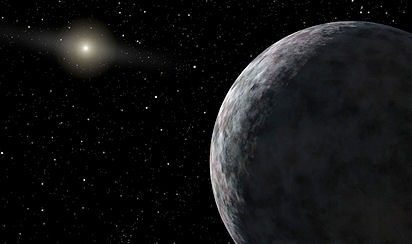
Image credit: NASA/JPL-Caltech
Either possibility would provoke further debate about the nature of the outer solar system. The scattered disk objects have anomalous orbits which indicate that they have been affected by another sizeable body in the past.
"...The most accepted theory of trans-Neptunian objects is that they should orbit at a distance of about 150 AU, be in an orbital plane – or inclination – similar to the planets in our Solar System, and they should be randomly distributed.
But that differs from what is actually observed. What astronomers see are groupings of objects with widely dispersed distances (between 150 AU and 525 AU) and orbital inclinations that vary between 0 to 20 degrees." (3)A number of theories have been put forward to explain their roaming elliptical paths beyond the carefully managed Kuiper Belt zone, whose own objects are shepherded by the planet Neptune. The most straightforward, at least theoretically, is that the scattered disk objects are perturbed by a substantial Planet X body which may or may not still lie somewhere further out. This sizeable, distant object would then have been perturbing these lesser objects by the 'Kosai mechanism' (3).
Trying to work backwards from the orbits of these affected bodies to the perturbing influence is likely to be a significant mathematical puzzle. But the stakes are sufficiently high that I've little doubt that that work is well underway. It strikes me as slightly odd that an announcement can be made about the presence of a moving object in the sky, whose provenance must have been determined quite carefully from several observations of the object over a period of time, yet at the same time its orbital parameters remain a mystery.
It makes me wonder whether, in the quiet but determined hunt for Planet X being undertaken by mainstream academic astronomers right now, some of them have, probably wisely, chosen to keep some of their data under wraps for now. After all, each data point - each new scattered disk object - potentially provides another piece of the mathematical puzzle which may allow them to work backwards to pinpoint the real prize...
Written by Andy Lloyd, 13th November 2015
References:
1) Astronomy Now Staff "Newly discovered dwarf planet is solar system’s most distant object" 12 November 2015
2) John Wenz "Newly Discovered Object Revives Speculation about Planet X" 10 November 2015, with thanks to Mart
3) Nancy Atkinson "Astronomers are Predicting at Least Two More Large Planets in the Solar System" 15 January 2015, with thanks to Lee
Raining Molten Iron
The weather here in Britain can be bad enough at times, but it's as nothing compared to the clouds of molten iron billowing around the sub-brown dwarf PSO J318.5-22. This particular free-floating 'L-Dwarf', positioned about 80 light years away, is about seven or eight Jupiter masses, and is young enough (at between 12 and 20 million years old) to be self-luminous, emitting 'extremely red' light (1). Curiously, though, almost all of the imagined images of this sub-brown dwarf on the internet cast its colour as purple. Even NASA has chosen this colour for its old-style 'Exoplanet Travel Bureau' poster.

Image credit: NASA's 'Exoplanet Travel Bureau'
This kind of object is, I suspect, similar in size and mass to my proposed Dark Star binary companion, although it's relative infancy allows it to be luminous in a way that our own Dark Star is no longer capable of, given that the Sun's proposed companion is several billions of years old. The purple hue may be nearer the truth for a far older L-Dwarf, like the Dark Star.
Because PSO J318.5-22 has no parent star, its own feeble red light is not overcome by that of an adjacent star. This has allowed astronomers to study the infra-red light emanating from the object over time, and draw some conclusions about the atmospheric conditions prevalent on the sub-brown dwarf. A team from the University of Edinburgh in Scotland used an infra-red telescope in Chile to image the interstellar planet hundreds of times as its rotated. Their analysis showed multiple layers of clouds, varying greatly in thickness. These clouds, which are at about 800 Celsius, contain 'hot dust and molten iron droplets' (2,3). If the Babylonian god Marduk did indeed take the form of a fiery object similar to this, then he was truly a god of steel!
Going back to the colour of Nibiru, an old Malaysian friend of mine points out the following, perhaps just a little tongue-in-cheek:
"The colour of planet Nibiru is blue. The name comes from two Malay words, 'Ni' (Ini - this) & 'Biru' (blue)." (4)
Of course, 'Nibiru' is an ancient Mesopotamian word which appears in the Babylonian Creation myth, the 'Enuma Elish', as one of the 50 names of the god Marduk:
"May he hold the Beginning and the Future, may they pay homage unto him,
Saying, "He who forced his way through the midst of Tiamat without resting,
Let his name be Nibiru, 'the Seizer of the Midst'!
For the stars of heaven he upheld the paths,
He shepherded all the gods like sheep!
He conquered Tiamat, he troubled and ended her life,"" (5)
Sumerologists have come up with a number of astronomical identities for Nibiru, their favourite being Jupiter. Yet, Nibiru was described by the Babylonian astronomers in one of their astrolabes as being red in colour, which Jupiter most certainly is not:
"The red star, which when the stars of the night are finished, bisects the heavens and stands there whence the south wind comes, this star is the god Nibiru-Marduk" (6)
This colour issue is important. Before Voyager 2 passed by Neptune and imaged it, Zecharia Sitchin correctly predicted its watery blue colour, based simply upon his reading of the ancient Sumerian texts and the descriptions of their 'gods'. This came after a similar corroboration of the colour of Uranus (7).
Many people on the Internet freely dismiss Sitchin as a 'fraud', which is difficult for him to defend against because unfortunately he passed on several years ago. In keeping with the aim of all propaganda dark arts, the accusation of fraud has successfully stuck, even though Sitchin appears to have believed in his own theory right up to the time of his death. He claimed to have got the colours of Neptune and Uranus right, which sounds more like scientific prediction than fraud to me. So, the colour of a predicted planet matters - and that extends to any future discovery of 'Nibiru'.
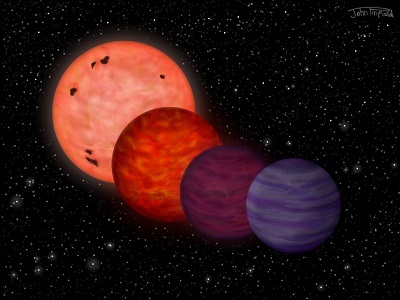
The Brown Dwarf Spectrum
If Nibiru is a terrestrial world, then it is probably grey and red, rather like Pluto. But I've argued that the 'planet' is more likely a sub-brown dwarf system (8), about which we know very little because they're so difficult to detect. The brown dwarf spectrum goes from red to magenta as you reduce mass, but for the cooler end of the spectrum no one really knows. I suspect it's purple for a sub-brown dwarf of several Jupiter masses, giving this world the appearance of a royal planet.
As just mentioned, the Babylonians described Nibiru as red, but that be because the planet flares up when moving into the Sun's enormous magnetic field during its perihelion passage, brightening its colour significantly. Or it might be that the observed Nibiru phenomenon is something else, like a outlying terrestrial world in the binary system skirting ours. When out in the outer reaches of the solar system, this old sub-brown dwarf could well be a lot more purple than red.
Written by Andy Lloyd, 25th November 2015
References:
1) Michael Liu et al. "The Extremely Red, Young L Dwarf PSO J318-22: A Free-Floating Planetary-Mass Analog to Directly Imaged Young Gas-Giant Planets". Astrophysical Journal Letters, 777: 2, L20, 10 November 2013
2) BBC News "Edinburgh astronomers make sunless planet discoveries" 3 November 2015, with thanks to John
3) University of Edinburgh Press Release "Weather Map of Distant World Revealed" 3 November 2015,
4) Correspondence from Prof Hazidi Al-Kajangi, 23 November 2015
5) L.W. King (Translator) "Enuma Elish: The Epic of Creation" 1902
sacred-texts.com/ane/enuma.htm
6) B. Van der Waerden "Science Awakening II: The Birth of Astronomy" pp66-68 Oxford University Press 1974
![]() Science Awakening II: The Birth of Astronomy
Science Awakening II: The Birth of Astronomy
7) Zecharia Sitchin "Genesis Revisited" pp7-12, Avon, 1990
8) Andy Lloyd "Dark Star: The Planet X Evidence" Timeless Voyager Press, 2005
Magnetic Field Strength
Dwarf stars can punch above their weight, as we have seen on innumerable occasions. They may be faint, but often they exhibit strong flare activity or, in the case of the ultra-cool dwarf star TVLM 513-46546, a hefty magnetic field. This cool star, which can be found 35 light years away in the constellation Boötes, is on the mass boundary of brown and red dwarfs, at about 90 Jupiter masses (1).
It's magnetic field is the strongest yet found for an ultra-cool dwarf star, except perhaps for those so young that they still have proto-planetary disks in place (2). So powerful, in fact, that the magnetic field around TVLM 513-46546 is likely to be associated with ferocious solar-flare-like eruptions (3), in keeping with the Sun's strongest magnetic zones. It's thought that the processes driving this unusually active field activity may be related to the dwarf star's speedy rotational rate, which is an impressively fast 2 hours.
Image credit: NRAO/AUI/NSF; Dana Berry / SkyWorks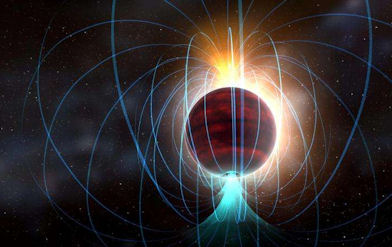
This potentially has implications for life-bearing planets around such dwarf stars. In this particular case, the habitable zone of TVLM 513-46546 is well within the destructive fields, meaning that the potentially habitable world would be in the firing line of high-frequency radiation bombardment from these stellar flares. Such worlds might have their own magnetic field defences, of course, but it might still create problems. Nevertheless, this finding indicates how these ultra-cool dwarf stars should not be underestimated!
Our own Earth's magnetic field offers us protection from the worst the Sun can send our way. That planetary magnetic field fluctuates over time, and there has been a lot of speculation within the Planet X field, and elsewhere, about the potential for an impending magnetic field flip in its polarity. That's largely based upon the fact that it's been about 780,000 years since the last reversal in the Earth's magnetic field, which is a much longer period than average between these events. Worse, the magnetic field strength of the Earth has been dropping steadily over the last 200 years, heightening concerns that a flip is on its way.
Reassuringly, perhaps, is new research that shows that today's level is still actually well above the average field strength over the last 5 million years (4). That provides us with quite a buffer before the planet reaches a critical point where a reversal in the magnetic field polarity is triggered, it is argued (5). In a world where we've already got quite enough to worry about, this is probably one less thing to concern ourselves with.
Written by Andy Lloyd, 25th November 2015
References:
1) TVLM 513-46546
2) P. K. Williams et al. "The First Millimeter Detection of a Non-Accreting Ultracool Dwarf," The Astrophysical Journal, 815: 64, 2015
3) Phys Org Staff "Cool, dim dwarf star is magnetic powerhouse" 19 November 2015
4) Phys Org Staff "Earth not due for a geomagnetic flip in the near future, researchers show" 23 November 2015, with thanks to John
5) H. Wang et al. "Weaker Axially Dipolar Time-averaged Paleomagnetic field based on Multidomain-corrected Paleointensities from Galapagos Lavas" PNAS,
112 (49) 15036-15041, 23 November 2015,
The Mystery of The Moon's Orbital Tilt
The generally accepted theory of the Moon's origin has been around for a while. It involved the early Earth having been struck by a Mars-sized body. The ejected debris from this colossal impact was not sufficiently energetic to escape the earth's gravitational field, and instead became a field or ring of debris orbiting the Earth. This eventually accreted into the Moon. The theory is still debated today, and some issues remain unresolved.
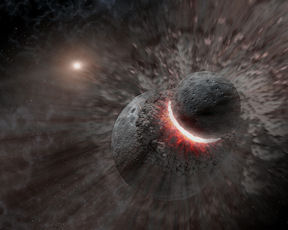
One such issue, which has come out of
more recent ideas about how planets form, is that the
Moon's orbit around the Earth should be aligned more or
less with the equatorial plane of the Earth. Instead, the lunar orbital tilt is set at
about five degrees from that plane, which is an order of
magnitude greater than theory allows. This is known as
the 'lunar inclination problem'.
"According
to the 'giant impact theory' the Moon is believed to
have been created by the collision of a Mars-sized
planet with the early proto-Earth about 4.5 billion
years ago. However, models of the giant impact
theory predict that the Moon's orbit around Earth would
only be tilted by about half a degree (at most) relative
to Earth's own orbit around the Sun." (1)
Perhaps that indicates that the long-held theory of the Moon's formation is incorrect. There are other possibilities to explain the anomaly, however. For instance, some astrophysicists have wondered whether the Earth once had a second smaller moon, now lost, whose influence was enough to disrupt the extant Moon's orbital inclination (2).
Or perhaps there was
another gravitational influence later which caused the
Moon's orbit to become more inclined? That's the
thinking behind a new series of computer calculations
conducted by astrophysicists based in the south of
France. They wondered what level of external
gravitational influence was required to cause this more
inclined lunar orbit, assuming that a body or bodies
passing close to our Earth-Moon system was sufficient to
nudge the Moon's orbit out of kilter.
"The
excitation of the lunar orbit is most readily reproduced
via collisionless encounters of planetesimals with the
Earth–Moon system with strong dissipation of tidal
energy on the early Earth." (3)
There are a lot of random elements at work here. Nevertheless, the result of the calculations generally showed that the mass of these objects needn't be spectacular to have the desired effect - perhaps as low as ~0.01 ME (Earth Mass) (3). After a number of influential 'fly-bys', these objects may have eventually collided with the Earth/Moon system, and thus disappeared into their still-forming bodies during a late point in the accreting process. It seems to me that this later conclusion is simply a neat piece of house-keeping. If the theory calls for a repeated series of fly-bys by sizeable chunks of rock, then where are they now? The easiest and neatest arrangement is for these bodies to have been absorbed by the Earth-Moon system once their perturbing work was done.
There are other possibilities, of course. 3.9 billion years ago, the inner solar system was subject to a massive bombardment of planetesimals. Their influence may have extended beyond the major impact craters we see today pock-marking the lunar surface. However, one might imagine that their interaction would have been more statistically random, such that any influence on the orbital path of the Moon would have been largely smoothed out. In other words, the passing showers of comets, if that's what they were, were hit-and-run affairs passing the Earth-Moon system on all sides and from all directions. I suspect that the calculated models mentioned in the paper above called from a repeated pattern of fly-bys with an emphasis on a collective gravitational influence from a single direction over time.
Another possibility is that the perturbing influence was not the repeated passing of a mass of small bodies, but instead a catastrophic passage of something much greater in mass - an event of great significance 3.9 billion years ago which, in one fell swoop, knocked the Moon's orbit out of line with the Earth's equatorial plane. One of the authors of the paper, Alessandro Morbidelli, has been influenced by such ideas in the past, as I have written about previously (4). He's shown a particular interest in the possibility of stellar fly-bys, or even the one-time presence of a brown dwarf in the solar system, to explain (the still unresolved) anomalies in the outer solar system (5).
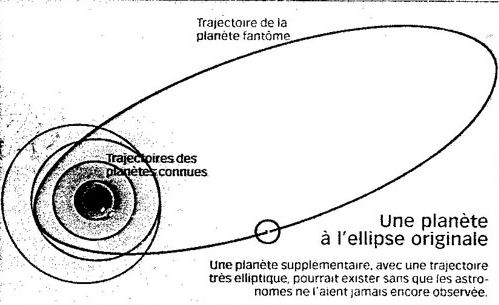
Indeed, Dr Morbidelli was featured in an article in the
French magazine "Science et Vie" (penned by Valerie
Greffos) which attracted the attention of author
Zecharia Sitchin due to the remarkably Sitchinite ideas
expressed therein:
"The assertion was based on
statements made to the journal by Alessandro Morbidelli,
an astronomer at France’s observatory at Côte d’Azur.
The Solar System, he explained, was chaotic in the
beginning. There was a celestial collision involving a
“supplementary planet” that had existed where the
Asteroid Belt is now. It happened about 3.9 billion
years ago; and those events explain the unusual long
elliptical orbit of the “Phantom Planet.” "“I
expect that one day we will discover a new, Mars-sized
planet!” he told the journal with certainty, a planet
whose orbital period is “several thousand years.” He
provided the journal with a sketch of the planet’s
elongated elliptical orbit and even indicated in the
sketch where the “Phantom Planet” is probably now"
(6)
Does Dr Morbidelli still 'believe' in this planète fantôme? I think this new research about the Moon's origin indicates that he might still be on the trail of Planet X. How so? Because the 'lunar inclination problem' might well be explained by catastrophic events which took place 3.9 billion years ago, the planetary origin of which still lies undiscovered in the outer solar system.
Written by Andy Lloyd, 29th November 2015
References:
1) Stuart Gray "Moon's orbit was tilted by close encounters with passing planetesimals" 25 November 2015, with thanks to Lee
2) M. Cuk & S. Stewart "The Puzzle of Lunar Inclination", EPSC-DPS Joint Meeting, Nantes, France, p 580, 2-7 October 2011,
3) Kaveh Pahlevan & Alessandro Morbidelli "Collisionless encounters and the origin of the lunar inclination" Nature, 527: 492–494, 26 November 2015,
with thanks to John
4) Andy Lloyd "Alessandro Morbidelli and the Origin of Sedna" 15 November 2004
darkstar1.co.uk/Morbidelli.html
5) A. Morbidelli and H. Levison "Scenarios for the Origin of the Orbits of the Trans-Neptunian Objects 2000 CR105 and 2003 VB12 (Sedna)" The Astronomical Journal, 128:(5), 2564
6) Zecharia Sitchin "The Case of the French Astronomer" 2004
Nearby Venus-like Planet Discovered
Red dwarf stars are plentiful, it seems, accounting for twelve times as many stars as their larger cousins, the Sun-like yellow dwarfs. Red dwarfs also have plenty of planets, too, including a recently discovered Earth-sized world orbiting one of these dim stars located 39 light years away, the red dwarf Gliese 1132 (1). The planet, known as GJ 1132b, is the closest known rocky exoplanet so far discovered, and offers scientists their best opportunity yet to study another Earth-like planet. However, although the planet orbits a dimmer, cooler star than our own, its cruising distance is much closer than the Earth is to the Sun, meaning that the planet is actually probably too hot for any kind of habitation. In other words, it lies way inside the inner edge of the habitable band known as the 'Goldilocks Zone'.
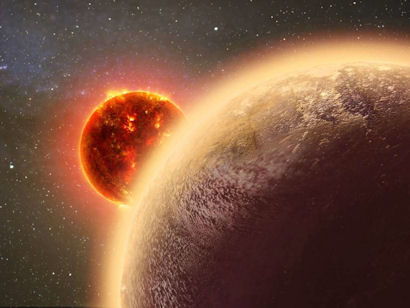
Photo Credit: Dana Berry/SkyWorks/NASA
So, it's more likely to resemble the Earth's sister world, Venus, which, like the goddess herself, is way too hot to handle. Despite this, the planet has a metal core, implying the potential for a protective magnetic field. So, GJ 1132b's discoverers are hopeful of an extant atmosphere which might be observable using some of today's cutting edge telescopes, like the Hubble Space Telescope.
""If we find this pretty hot planet has managed to hang onto its atmosphere over the billions of years it's been around, that bodes well for the long-term goal of studying cooler planets that could have life," said Massachusetts Institute of Technology's Zachory Berta-Thompson [The paper's lead author (2)]." (1)
It's probably fair to say that this finding is not going to set the general public's pulse racing, but scientists will see in this a golden opportunity to obtain data about conditions on a rocky planet outside of our solar system. the fact that the planet orbits a dwarf star is particularly helpful, because the reflected light from the planet will not be completely blasted out by that of the parent's star's. Which means that scientists will be on the hunt for rocky exoplanets orbiting old low mass stars, like Gliese 1132.
Hopefully, then, as more brown dwarfs (which are even smaller and dimmer than red dwarfs) get discovered in our neighbourhood, their potential planets will be even more sought after by planetary scientists, eager to image these worlds and their atmospheres directly. That brings the prospect of Earth-like planets being found orbiting around brown dwarfs that much closer.
Written by Andy Lloyd, 12th November 2015
References:
1) Deborah Netburn "Scientists think they just found the most important planet outside our solar system" Los Angeles Times, 12 November 2015
2) Z. K. Berta-Thompson et al "A rocky planet transiting a nearby low-mass star" Nature, 527, 204–207, 12 November 2015, with thanks to John
Tony Hancock and the Red Planet
I was amazed today (30/11/2015) to hear a re-recorded episode of Hancock's Half Hour, which centred around an alleged incoming red planet. Written in 1955, this Planet X reference preceded Sitchin by 21 years, and was most likely influenced by Velikovsky's "Worlds in Collision", which was first published in 1950. It's available to listen to for the next 29 days on the iPlayer, and is, of course, very funny:
"The Red Planet: Tony (Hancock) takes up astronomy, and discovers something terrible among the stars."

You can keep informed of updates by following me on Twitter:
![]()
Or like my Facebook Page: https://www.facebook.com/darkstarandylloyd